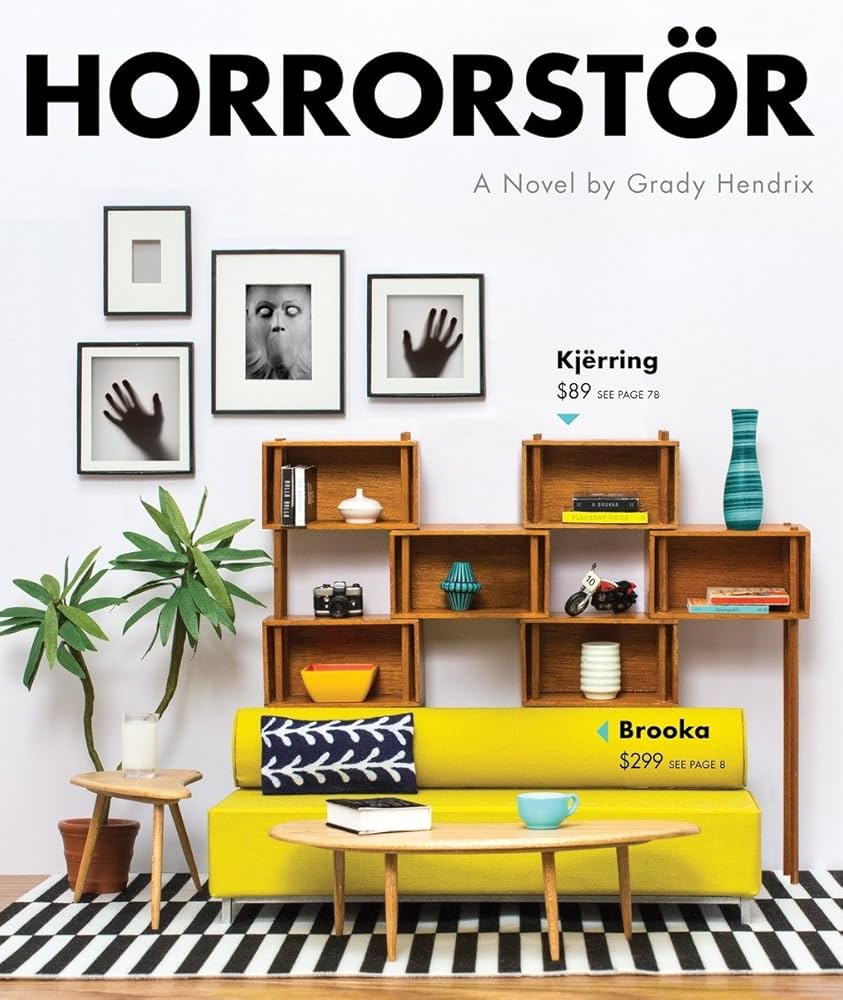Genre: Horror
Premise: A group of workers at an Ikea-like store find themselves lost within its maze-like interior after a late-night seance goes wrong.
About: Horrorstor was published in 2013. New Republic Pictures optioned the book to turn it into a movie in 2020. Before that, it was conceived as a TV series, with screenwriting royalty Charlie Kaufman set to adapt. The heat off the Horrorstor sale led to writer Grady Hendrix’s latest novel,The Southern Book Clubs Guide to Slaying Vampires, selling to Amazon in a ten buyer bidding war.
Writer: Grady Hendrix
Details: about 250 pages

I had my eyes on this one ever since it sold.
It’s a genius idea. Placing a horror film in an Ikea store!? Story perfection.
Why?
Because I like fresh angles into old genres. I’d never seen this combo before. And it gets more clever the more you think about it. I remember when I used to go to Ikea (back when everybody was going) and thinking, “This place is kind of like Hell.” It’s this never-ending maze that sucks you in and forces you to buy a lot of things you don’t need.
I was curious to see what the author would do with it. Let’s find out.
24 year old Amy works at Orsk, an Ikea knock-off that somehow has even lower prices than the infamous Swedish furniture store. Amy has had a tough life. She grew up in a trailer. Her mother has had numerous boyfriends. Without higher education, she’s been stuck in a cycle of barely-above-minimum-wage jobs. Orsk is the culmination of that cycle.
But even though she hates her job, she needs it. Which is why she’s freaking out on this particular morning. Word on the street is that firings are coming. And Amy is the most fireable employee there. She shows up one minute before work and leaves the second the clock strikes 5. She is the epitome of a worker who only thinks about herself.
So when she’s called in to see her boss, Basil, she’s surprised to see Ruth Anne waiting outside his office. 42 year old Ruth Anne is the hardest worker there. She can’t possibly be getting fired as well? Turns out her instincts are correct. Company man Basil tells them he’s not firing them. He needs them for a special top secret job.
Someone is sneaking into the store after hours and smearing their feces on the furniture. He needs Amy and Ruth Anne to help him monitor the building that night. Amy agrees only because Basil promises to give her a transfer to another better Orsk store in the city. So away they go.
Amy and Ruth Anne think they find the culprits but it turns out to be co-workers Matt and Trinity, who have secretly been hooking up after hours. Tonight, Trinity is leading the two on a ghost hunt, complete with a running camera. Her dream is to get a real ghost on video so she can start her own ghost-hunting show (“Ghost Bomb”). Matt, meanwhile, is clearly going along with it to get laid.
Matt and Trinity join Amy and Ruth Anne, eventually finding the real culprit, a guy named Carl. Carl is homeless and has been sneaking in here at night to sleep. But Carl swears he’s not smearing any bodily functions on the furniture. Trinity, who’s pissed off that Carl isn’t a ghost, implores everyone to join her in a seance, since seance scenes always do well in these ghost hunting shows.
At first, the seance is fun, until Carl takes on the persona of someone named “Josiah.” Josiah informs all of them that they’re dead meat. And he’s very convincing, speaking in a different voice and everything. It’s enough to get them to stop the seance. But the damage has already been done. When they try to get back to the main showroom, they keep going in circles for some reason. That’s when they realize that Orsk is no longer a fun store. It’s a giant maze and there’s no way out.
Except that somehow, Amy does find a way out. She gets to her car in the parking lot and is ready to get the hell out of there. But something tugs at her. She’s been selfish her entire adult life. Does she really want to leave her co-workers here to die? Or should she go back into this panopticon and get them out of there?

Horrorstor is, basically, a screenplay. It’s written like one so it can be treated like one for the sake of today’s analysis.
I want to bring particular attention to how the story starts. A lot of writers know they need to start their screenplays with something happening in order to grab the reader. But they erroneously believe that “something happening” means something big, such as a car chase or someone getting murdered or an exciting flash-forward.
That’s not true.
With a little knowledge, you can use more restrained story mechanisms to “make things happen” early on and pull the reader in as a result.
For example, Amy shows up to work at Orsk. For the sake of argument, I want you to imagine you’re writing this movie. You’re bringing your main character to work in the morning. How are you going to write these opening scenes to pull the reader in?
I’ll tell you what bad writers will do. They’ll show the beginnings of the protagonist’s day. They’ll show them get to work. They’ll show them talking with their co-workers. They’ll show them prepping for opening. They’ll show them dealing with the first customers.
I can see how, in one’s head, that would make sense. You’re setting up the main character and the main location. So you are achieving something.
But, what you aren’t doing is giving the reader a reason to keep reading. What’s making me want to turn the page here? To see my main character at work? Why would that be interesting? Why would I want to see someone at work? I see people at work every day of my life. Why would you think that showing more people at work would capture my interest?
Here’s what author Grady Hendrix did instead. He zoomed in on the fact that firings are coming and our main character is, likely, first on the chopping block. Not only that. But he establishes that Amy *cannot* lose this job. She’s about to be kicked out of her place by her roommates for being late on her end of the rent again.
Do you see the difference in terms of storytelling here? This isn’t just someone showing up to work. This is someone trying to avoid getting fired. Now I have a reason to turn the page. I have to see if she’s going to get fired or not! Storytelling can be as simple as that. You put out a carrot. You stack some stakes on top of that carrot. And people will keep reading. As soon as you get to the carrot, introduce another carrot. And so on and so forth.
But Horrorstor runs into some problems once it moves into its horror storyline. I don’t like when story points emerge accidentally. I like them to feel planned. Carl the Homeless Guy shows up. Turns out he’s just a normal dude. This puts the plot on ice for a chapter. We’re not sure why we need to keep reading other than the author is still typing words.
And then Trinity says, “Let’s do a seance!” It sort of makes sense in that she needs footage for her ghost-hunting show. But it’s a lazy development that comes out of nowhere. And when Carl takes on this Josiah personality, it’s too convenient of a plot beat. Seconds ago Carl was a dead story thread. Now he just happens to channel this evil entity who will power the rest of the narrative?
To be clear, Josiah was set up beforehand. He’s the warden of an old prison back in the 1800s which used to reside on the land Orsk is built on. But it still felt entirely convenient that this homeless dude happens to channel this guy during a seance that someone came up with five minutes ago as a spur of the moment idea that seemed to spring from the fact that the story had lost its plot.
But then the story rebounds when it focuses on them getting lost in Orsk due to the fact that it was building on the clever idea that people get lost in Ikea all the time and the only way out is to go through every single entire room in the building to ensure that you purchase as many things as possible. It was reminiscent of the kind of social commentary you saw in George A. Romero’s, Dawn of the Dead, with the zombies crawling back into the malls so they could consume consume consume.
So whenever our heroes were trying to find their way out, only to find themselves deeper and deeper within the caverns of the Orsk maze, I liked the book.
I also liked what Hendrix did with Amy’s character. She’s established as this woman who only cares about herself and doesn’t subscribe to the “family” theme Orsk promotes, that everyone who works there should help each other. I always tell you guys that, late in your script, your main character should face a choice, preferably one that challenges her primary character flaw.
That’s what we get from Amy. She’s in the parking lot. She’s free and clear to go. But then she realizes that, if she leaves, these people may die. Does she stick with her selfish approach to life and save her own ass? Or does she help the others?
Why hasn’t this movie been made yet?
It’s a challenging sell! Terrifier 3 is doing well because of how unapologetically it leans into the horror genre. “Scary clown” is the logline. That’s all it needs to be. Setting a horror film in an environment like an Ikea doesn’t come anywhere close to the marketability of a scary clown. It’s a risk. True, it’s a risk that, if it pays off, it looks amazing. But it’s still a risk.
What sucks is that Ikea is no longer a pop culture store like it used to be. So any movie set in one is going to feel dated.
But, you never know. I still think it’s a fun idea.
[ ] What the hell did I just read?
[ ] wasn’t for me
[x] worth the read
[ ] impressive
[ ] genius
What I learned: Cerebral Horror is a great screenplay “feature” but it should never be the main attraction. The reason this sold is because of the cerebral nature of the concept. People in Hollywood love that stuff. But audiences don’t care about that as much, especially when it comes to the horror genre. Imagining Ikea as Hell is fun. But it’s not as scary as a crazy clown killing people. So make sure if you come up with a cerebral horror idea, it still has something genuinely scary in it.

